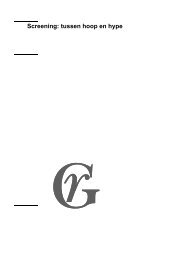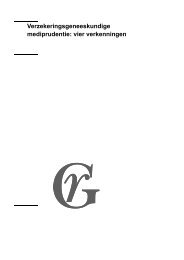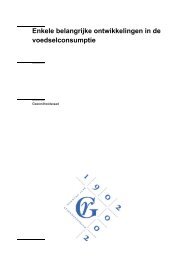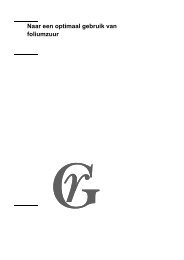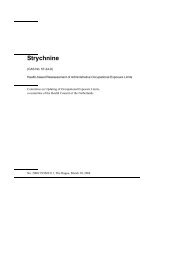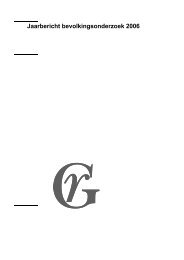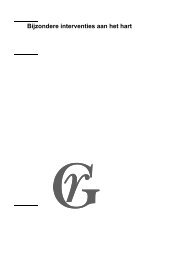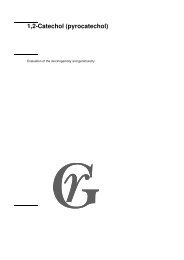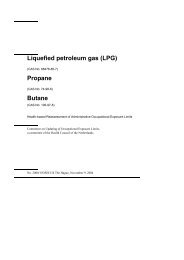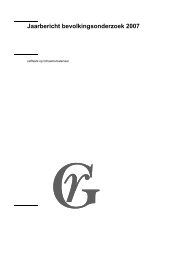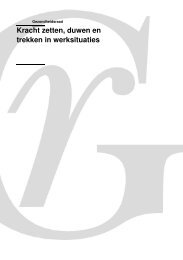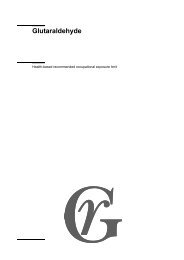Gezondheidsraad Dr. W.F.J.P.M. ten Berge Wolter Visscherstraat 40 ...
Gezondheidsraad Dr. W.F.J.P.M. ten Berge Wolter Visscherstraat 40 ...
Gezondheidsraad Dr. W.F.J.P.M. ten Berge Wolter Visscherstraat 40 ...
Create successful ePaper yourself
Turn your PDF publications into a flip-book with our unique Google optimized e-Paper software.
G e z o n d h e i d s r a a d<br />
H e a l t h C o u n c i l o f t h e N e t h e r l a n d s<br />
Subject : comments on draft report 1,3-Butadiene<br />
Our reference : I 1<strong>40</strong>1/BJB/fs/459-O68<br />
Page : 2<br />
Date : May 31 st , 2013<br />
Regarding the use of ‘peak exposure’ data rather than cumulative exposure, as advocated by<br />
Sielken et al. (2007, 2011), the Committee stays with its opinion that the exposures from high<br />
in<strong>ten</strong>sity tasks are rather ill-defined, and thus unreliable if taken as the sole basis for a risk<br />
estimation (as outlined in section 3.1). But it must also be emphasized that exposure data of high<br />
in<strong>ten</strong>sity tasks were actually used, in that these data are implicitly included in the Committee’s<br />
conditioning of the exposure-response modelling of the cumulative exposure data (see section 3.2).<br />
In the Committee’s life table analysis you object to the cumulative exposure being held constant at<br />
the end of the occupational exposure at the age of 60. This approach is, however, consis<strong>ten</strong>t with<br />
the underlying epidemiological data which uses cumulative exposure as the exposure metric and<br />
does not allow for modification of risk after cessation of exposure. As such, even if reasonable<br />
assumptions could be made on the rate of decline in risk after cessation of exposure, the underlying<br />
epidemiological risk data would not be sufficient to perform such an analyses. The Committee<br />
therefore prefers to follow its standard approach as detailed in the Health Council’s Guideline<br />
to the estimation of cancer risk values for carcinogenic substances (Leidraad berekening<br />
risicogetallen voor carcinogene stoffen, The Hague, The Netherlands, 2012; publ. no. 2012/16. An<br />
English version of this guideline is to be published shortly). In addition it must be noted that the<br />
mortality in the cohort after the age of 75 years increases dramatically, so that any excess due to<br />
leukaemia mortality after occupational exposure has a relatively small influence on the outcome of<br />
the analysis.<br />
The Committee appreciates your views on the toxicokinetics of 1,3-Butadiene in connection to<br />
peak exposures. These are very interesting from the scientific point of view, but the Committee is<br />
of the opinion that as yet it is not possible to use these as a solid basis for a (quantitative governmental)<br />
risk estimation.<br />
Enclosed you will find a copy of the final report.<br />
Yours sincerely,<br />
<strong>Dr</strong>. A.J. Baars<br />
Scientific Secretary<br />
P o s t a l a d d r e s s<br />
V i s i t i n g A d d r e s s<br />
P . O . B o x 1 6 0 5 2 R i j n s t r a a t 5 0<br />
NL- 2 5 0 0 B B T h e H a g u e<br />
NL- 2 5 1 5 XP T h e H a g u e<br />
T e l e p h o n e + 3 1 ( 7 0 ) 3<strong>40</strong> 6 6 3 1<br />
T h e N e t h e r l a n d s<br />
E - m a i l : j o l a n d a . r i j n k e l s @ g r . n l<br />
w w w . h e a l t h c o u n c i l . n l



